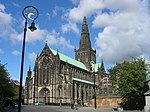Princess Royal Maternity Hospital
1834 establishments in ScotlandHospital buildings completed in 2001Hospitals established in 1834Hospitals in GlasgowMaternity hospitals in the United Kingdom ... and 4 more
NHS Greater Glasgow and ClydeNHS Scotland hospitalsOrganisations based in Glasgow with royal patronageUse British English from July 2015

The Princess Royal Maternity Hospital is a maternity hospital in Glasgow, Scotland. It was founded as the Glasgow Lying-in Hospital and Dispensary in 1834 in Greyfriars Wynd, just off the city's High Street. It moved to St Andrew's Square in 1841, then to Rottenrow in 1860 and to the Glasgow Royal Infirmary site in 2001. It is managed by NHS Greater Glasgow and Clyde.
Excerpt from the Wikipedia article Princess Royal Maternity Hospital (License: CC BY-SA 3.0, Authors, Images).Princess Royal Maternity Hospital
Castle Street, Glasgow Townhead
Geographical coordinates (GPS) Address Website Nearby Places Show on map
Geographical coordinates (GPS)
| Latitude | Longitude |
|---|---|
| N 55.8651 ° | E -4.2308 ° |
Address
Glasgow Royal Infirmary
Castle Street
G4 0ET Glasgow, Townhead
Scotland, United Kingdom
Open on Google Maps









